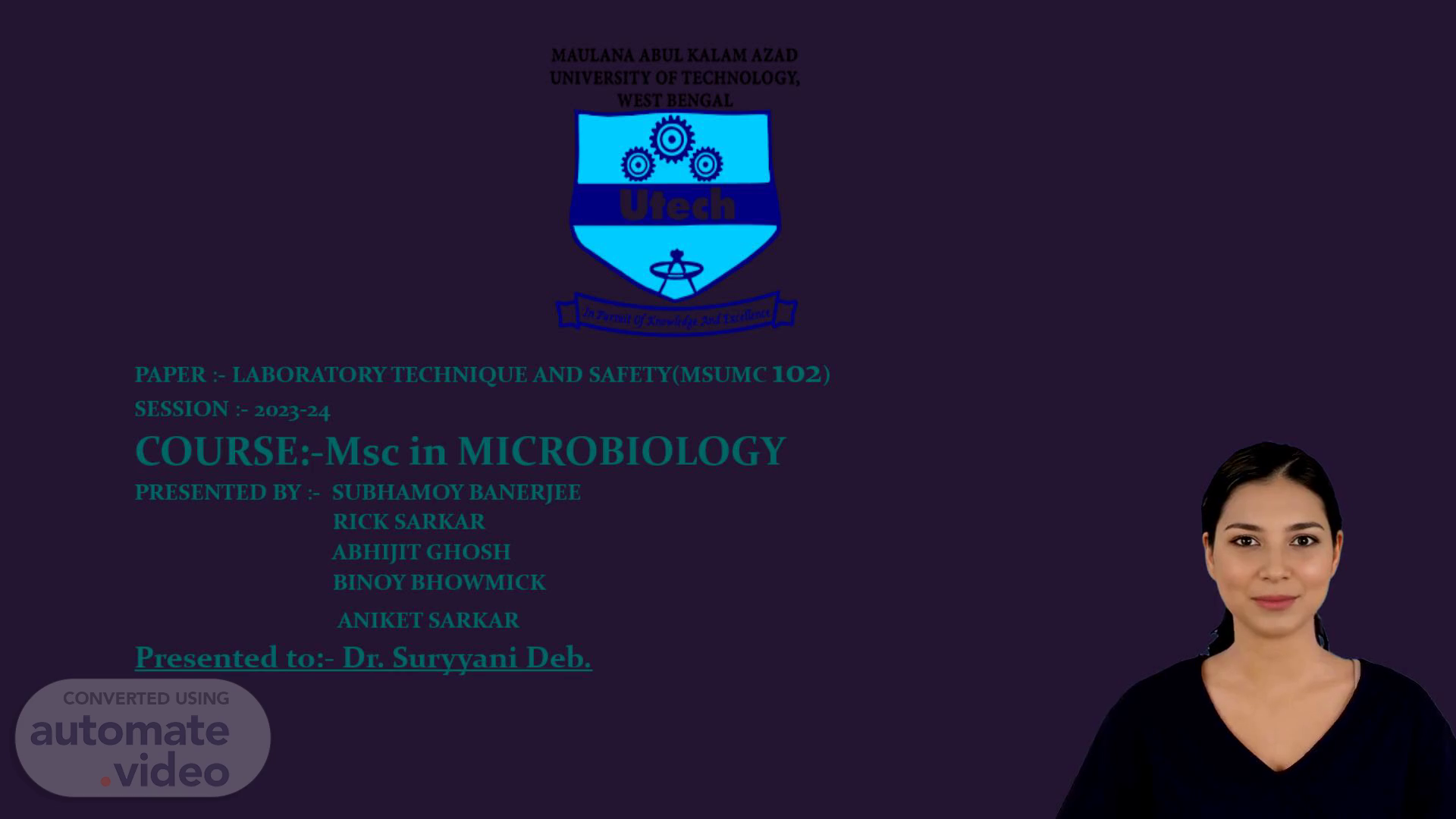
PptxGenJS Presentation
Scene 1 (0s)
[Virtual Presenter] This paper outlines the laboratory techniques and safety measures that will be taught to MSc students in the Microbiology course in 2023-24. Our team of five has discussed the importance of working in the lab environment and the precautions that need to be taken for best practices. We have also made sure to educate the students on the potential hazards that can occur and how to mitigate any risks. Additionally, we will be providing practical training on laboratory techniques and safety measures to ensure a seamless transition into the course. We hope that this paper will provide the students with the skills and knowledge needed to succeed in their studies." This paper is an important milestone for our Microbiology course for the upcoming academic year 2023-24. Our team of five has worked diligently to explore the various laboratory techniques and safety measures that need to be taken into consideration for students to be successful in their studies. We have also discussed the potential hazards and how to mitigate any risks that may occur, as well as providing practical training in the laboratory. It is our hope that this paper will ensure the students have the necessary skills and knowledge to excel in their course..
Scene 2 (1m 15s)
[Audio] DNA supercoiling is a complex process which plays a significant role in the organization and regulation of DNA. It involves the twisting of the double helix to create either positive or negative supercoils. Negative supercoils are generated when the double helix is twisted into a more compact form, while positive supercoils are the product of unwinding. DNA supercoiling has a plethora of applications making it an important concept to understand. It enables us to manipulate DNA in order to gain important knowledge of its structure, function, and organization. Additionally, it can be used to measure the effects of environmental and physiological conditions on DNA. Lastly, gaining an understanding of DNA supercoiling is necessary to comprehend laboratory techniques and safety protocols in the field of microbiology..
Scene 3 (2m 14s)
[Audio] DNA supercoiling involves the formation of additional twists on the DNA double helix, leading to a more compact structure. Negative supercoiling occurs when there is underwinding and positive supercoiling occurs when there is overwinding. Both of these processes can have a direct impact on the functionality of the DNA. This is an important topic to be considered in the MSc in Microbiology course of 2023-24..
Scene 4 (2m 45s)
[Audio] DNA supercoiling is an essential element in both the compaction and regulation of DNA in the cell. To fit into an extremely small space, the cell nucleus, DNA must be compacted. This compaction is enabled by DNA supercoiling. Moreover, it affects the availability of DNA to the various proteins engaged in gene expression and regulation, thus making the right supercoiling of DNA necessary for the proper functioning of any cell..
Scene 5 (3m 18s)
[Audio] Regarding DNA supercoiling, there are two main types - positive and negative supercoiling. Positive supercoiling causes the DNA to be overwound, which helps it to be packaged and compacted. Meanwhile, negative supercoiling is the opposite, leading to the DNA being underwound, which allows it to be easily unwound and gene expression to occur..
Scene 6 (3m 44s)
[Audio] Topoisomerase is a crucial enzyme involved in DNA supercoiling. It is a vital protein enzyme that helps to regulate the degree of supercoiling. It is an essential element in sustaining genetic stability and thus ensuring proper gene function. By its dynamic modulation, it helps to keep the genomic structure of DNA in balance so as to ensure cellular health..
Scene 7 (4m 11s)
[Audio] Enzymes known as topoisomerases play a significant role in the curling and uncurling of DNA. Various types of topoisomerases are responsible for diverse operations in the process of supercoiling, including those related to DNA repair and those primarily devoted to the winding and unwinding of the strands. This paper deals with topoisomerases and their influence on DNA construction..
Scene 8 (4m 39s)
[Audio] Enzyme topoisomerase has a crucial part in DNA supercoiling and relaxation process. It achieves this by allowing the double helix strands to part temporary by introducing controlled breaks, thereby releasing the tension caused by the coiling. Subsequently, after completing the necessary changes to the DNA, the double helix strands are rejoined, thus concluding the relaxation process. This is a major aspect of the Msc in Microbiology course of 2023-24 in terms of laboratory techniques and safety..
Scene 10 (5m 22s)
[Audio] We hope this presentation has been useful to deepen our understanding of the importance of understanding DNA supercoiling and Topoisomerase for laboratory technique and safety in the Msc in Microbiology program for the 2023-24 academic year. The conclusion and significance of these processes is key to the overall genome stability of any cell and influencing essential cellular functions such as gene expression, DNA repair, and genome stability. Again, thank you for your attention..